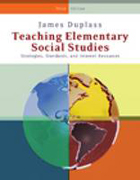
Teaching elementary social studies: Strategies, Standards, and Internet Resources
Duplass, James A.
Written for the elementary social studies methods course, this "interactive" program features a combined textbook-workbook that is thoroughly integrated with a dynamic website. To accommodate the visual preferences of today's collegestudents, the layout of the print text features a larger-than-usual font, bulleted lists, and contemporary graphics. The program's interactive approach andflexibility allow instructors to model the kinds of teaching principles and practices that students will want to use in their own elementary school classrooms. These principles and practices are integrated throughout the text and include active-learning strategies, application of constructivist principles, a focus on big ideas and thinking skills, use of the Internet, and modeling of best practices and performance-based assessments (based on INTASC and NCATE standards). As a result, the book serves as a springboard for classroom activities, website explorations, and/or instructor-led activities. INDICE: Unit 1: INTRODUCTION TO SOCIAL STUDIES FUNDAMENTAL GOALS. 1. WhatIs Social Studies Education? 2. Social Studies Knowledge. 3. Character Education. 4. Citizenship Education. 5. Multicultural and Global Education. Unit 2: PLANNING SOCIAL STUDIES INSTRUCTION. 6. Expanding Communities and Core Knowledge Frameworks. 7. Instructional Models. 8. Lesson Planning. 9. Choreography ofInstruction. 10. Internet Resources, Sources and Safety. 11. Creating Lesson Plans Using Internet Resources. 12. Adapting Internet Activities and Lesson Plans to Your Classroom. Unit 3: ASSESSING STUDENT LEARNING IN SOCIAL STUDIES. 13. Assessment. 14. Alternative Assessment. 15. Traditional Assessment. Unit 4:SOCIAL STUDIES DISCIPLINES, STANDARDS, AND INTERNET RESOURCES. 16. National and State Standards. 17. Social Studies, Standards, and Internet Resources. 18.History, Standards, and Internet Resources. 19. Economics, Standards, and Internet Resources. 20. Geography, Standards, and Internet Resources. 21. Government, Standards, and Internet Resources. 22. Social Sciences, Topical Approaches, and Internet Resources. Unit 5: LITERACY AND BASIC SKILLS IN SOCIAL STUDIES. 23. Reading Strategies for Social Studies. 24. The Crucial Role of Social Studies Vocabulary. 25. Textbooks and Social Studies Instruction. 26. Children'sLiterature and Social Studies Instruction. 27. Writing and Presentations. 28.Primary Documents and Realia. 29. Charts and Statistics. 30. Creating and Interpreting Maps. 31. Chronological Thinking and Timelines. Unit 6: SOCIAL STUDIES INSTRUCTIONAL APPROACHES. 32. Strategies and Direct and Indirect Instruction. 33. Concept Formation. 34. Active Versus Passive Learning. 35. Critical Thinking Skills. 36. Problem Solving and Decision Making. 37. Values Formation. Unit 7: SOCIAL STUDIES METHODS 38. Modeling and Metacognition. 39. Lecture. 40.Questioning. 41. Analogies. 42. Concept Organizers. 43. Group Learning. 44. Practice and Homework. 45. Self-Directed Learning and Learning Centers. 46. Role Playing and Games. 47. Discussion and Case Studies. 48. Service Learning, Field Trips and Guests Speakers. 49. Video and Sound Recordings. 50. Conclusion--Integrating What You Have Learned. List of Assignments and INTASC Standards Correlations. References. Index.
- ISBN: 978-0-495-81282-1
- Editorial: Wadsworth Publishing
- Encuadernacion: Rústica
- Páginas: 439
- Fecha Publicación: 01/01/2010
- Nº Volúmenes: 1
- Idioma: Inglés
